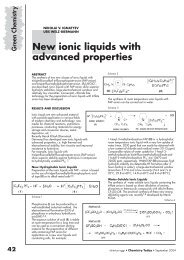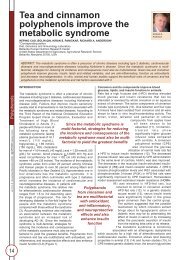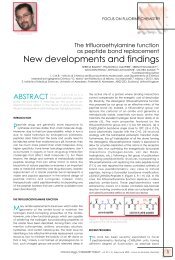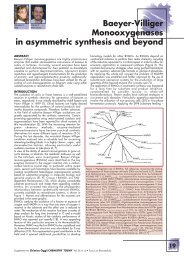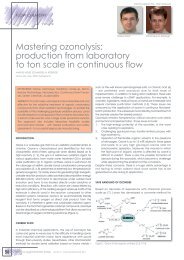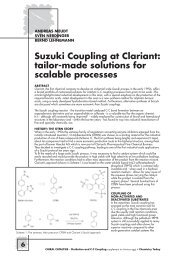Lake Como 2|4 October 2011 - CHIMICA Oggi/Chemistry Today
Lake Como 2|4 October 2011 - CHIMICA Oggi/Chemistry Today
Lake Como 2|4 October 2011 - CHIMICA Oggi/Chemistry Today
Create successful ePaper yourself
Turn your PDF publications into a flip-book with our unique Google optimized e-Paper software.
SPEAKER SPEAKER SPEAKER SPEAKER SPEAKER SPEAKER SPEAKER SPEAKER SPEAKER SPEAKER SPEAKER SPEAKER SPEAKER SPEAKER SPEAKER SPEAKER SPEAKER SPEAKER SPEAKER SPEAKER SPEAKER SPEAKER SPEAKER SPEAKER SPEAKER SPEAKER SPEAKER SPEAKER SPEAKER SPEAKER SPEAKER SPEAKER SPEAKER SPEAKER SPEAKER SPEAKER SPEAKER SPEAKER SPEAKER SPEAKER SPEAKER SPEAKER SPEAKER SPEAKER SPEAKER SPEAKER SPEAKER SPEAKER SPEAKER SPEAKER SPEAKER SPEAKER SPEAKER SPEAKER SPEAKER<br />
ABSTRACT<br />
BIOGRAPHY<br />
Scaling up fl ow reactors (Biotech case study)<br />
Gilda Gasparini<br />
AM Technology - UK<br />
Gilda Gasparini<br />
Gasparini graduated in Chemical Engineering at Universitá degli Studi di Bologna and took<br />
her PhD in Chemical Engineering at Loughborough University. Her research was focused on<br />
particle production by emulsifi cation techniques for controlled release drug administration.<br />
Since <strong>October</strong> 2008 she is responsible for AM Technology continuous reactors. She has been<br />
involved in the design development and she is following a number of projects including FP7<br />
projects involving the Cofl ore ACR for APIs production and crystallization and a TSB funded<br />
project on biocatalysis.<br />
Unlike batch reactors, the output of a fl ow device can be changed without altering the hardware or set-up conditions. This<br />
fl exibility saves time and cost in development. The improved control capabilities of fl ow systems can also deliver better yield and<br />
productivity. However, the use of fl ow reactors in bio applications are still limited. Traditionally, fl ow systems have been considered<br />
unable to handle multiphase systems and long reaction time effi ciently. Three UK technology companies, C-Tech Innovation,<br />
Ingenza and AM Technology are collaborating to develop new fl ow process techniques for bio manufacturing. The project will<br />
integrate all aspects of bioprocess development from catalyst discovery and engineering, to process design, through to small<br />
footprint manufacturing of high value products.<br />
The objectives of this project is to design a compact fl ow reactor for continuous bio processing and develop improved process<br />
design techniques to accelerate the introduction of new bio-manufacturing processes for a variety of product types such as<br />
unnatural amino acids and chiral amines.<br />
Results will be shown shown based on the biocatalytic oxidase of the D-amino acid giving a mixture of L-amino acid and the a-ketoacid<br />
using wild-type D-amino acid oxidase. This is a multi-phase multi-phase reaction (G/L/S) with a reaction time in batch of over 24 hours. hours. Tests on<br />
the optimization optimization from batch to continuous at the lab scale have already shown shown a reduction in reaction time from 24 24 to 3 hours hours and<br />
the following production scale up study results results will will be shown and discussed.<br />
13<br />
<strong>Lake</strong> <strong>Como</strong><br />
<strong>2|4</strong> <strong>October</strong> <strong>2011</strong>



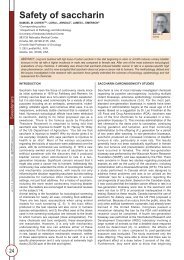
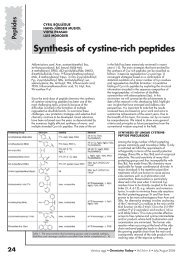
![Pietro Delogu [modalità compatibilità]](https://img.yumpu.com/12255149/1/190x135/pietro-delogu-modalita-compatibilita.jpg?quality=85)
